(PDF) Evaluating emergency management after an event
VerifiedAdded on 2021/02/20
|8
|2550
|66
AI Summary
Contribute Materials
Your contribution can guide someone’s learning journey. Share your
documents today.
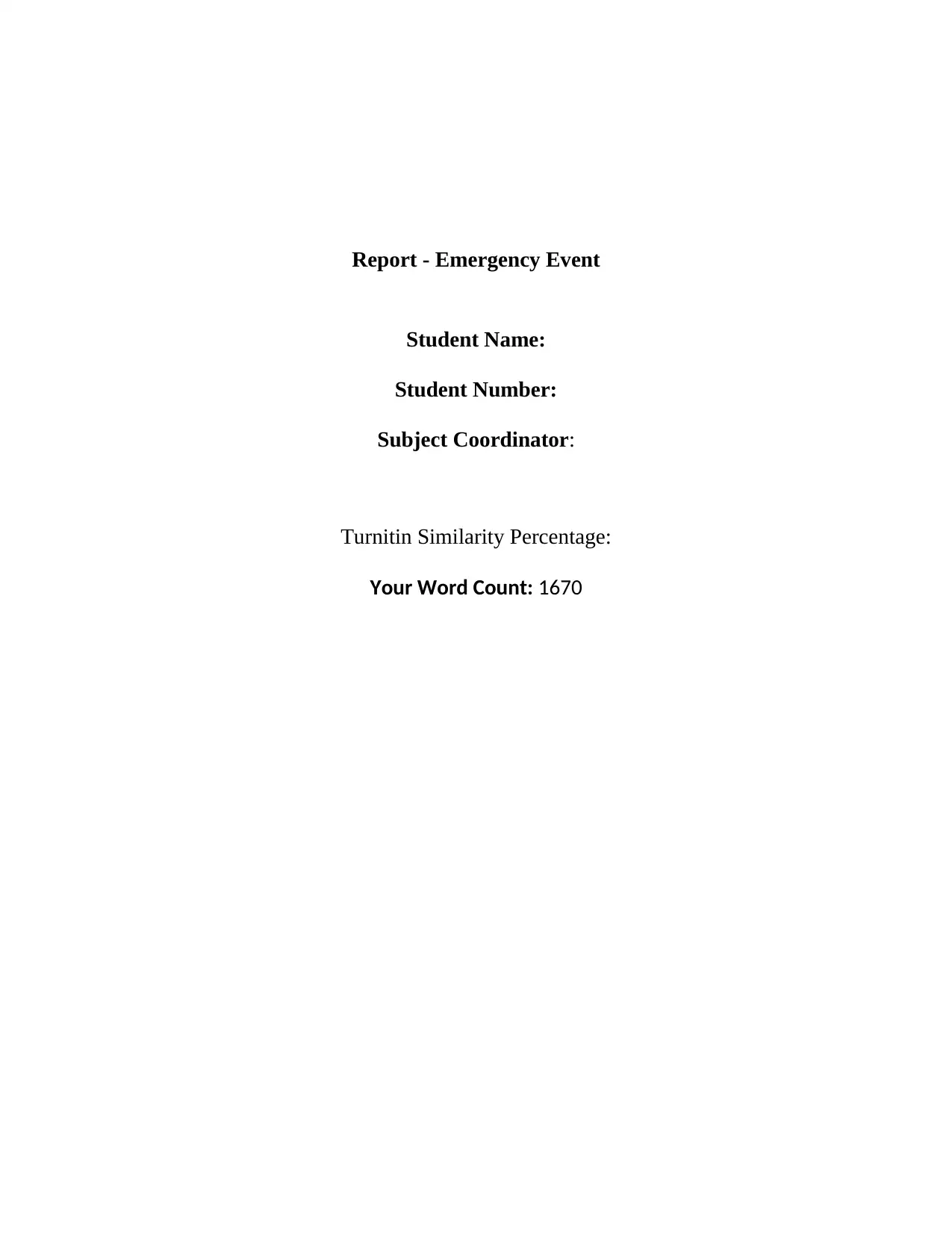
Report - Emergency Event
Student Name:
Student Number:
Subject Coordinator:
Turnitin Similarity Percentage:
Your Word Count: 1670
Student Name:
Student Number:
Subject Coordinator:
Turnitin Similarity Percentage:
Your Word Count: 1670
Secure Best Marks with AI Grader
Need help grading? Try our AI Grader for instant feedback on your assignments.
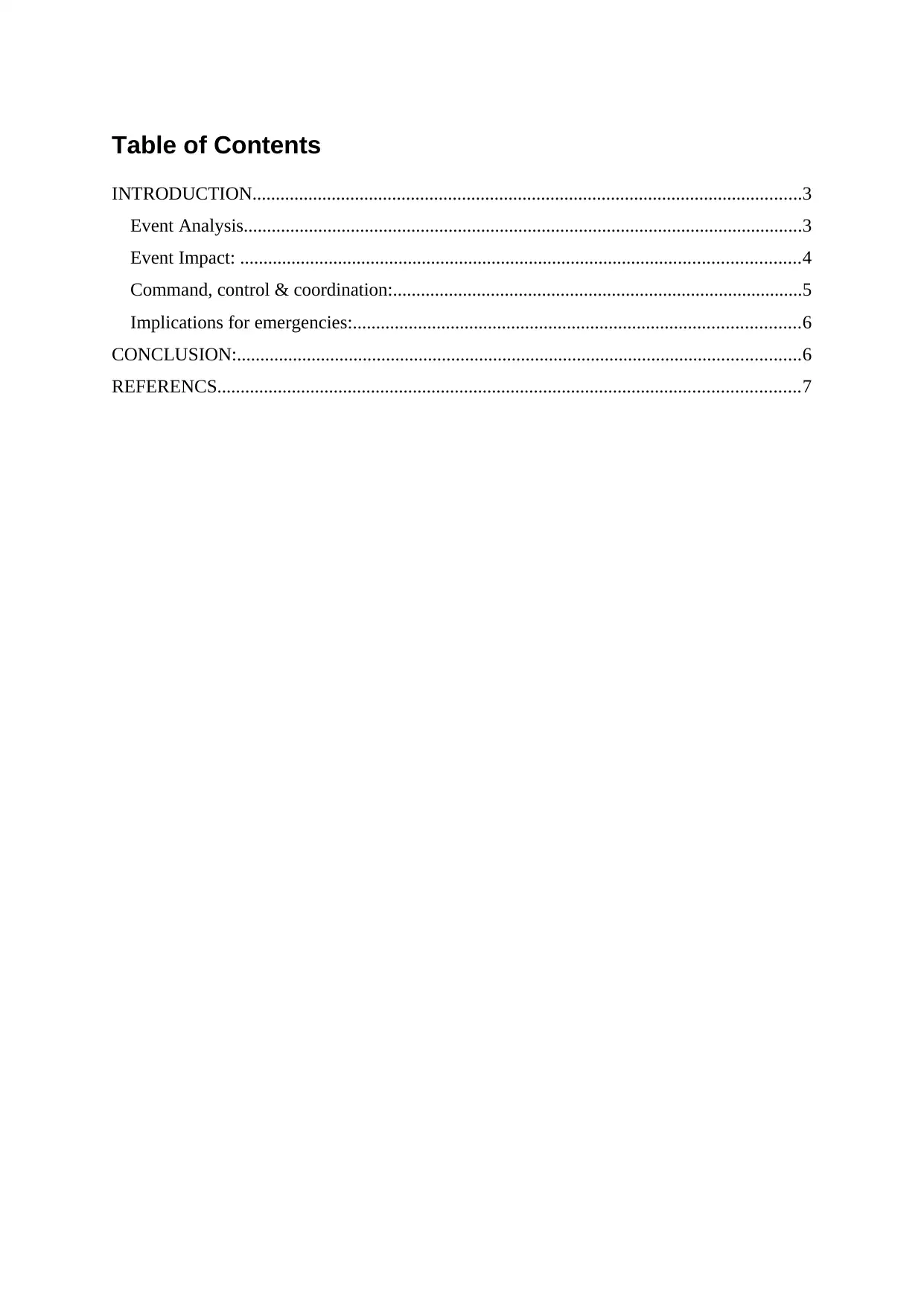
Table of Contents
INTRODUCTION......................................................................................................................3
Event Analysis........................................................................................................................3
Event Impact: ........................................................................................................................4
Command, control & coordination:........................................................................................5
Implications for emergencies:................................................................................................6
CONCLUSION:.........................................................................................................................6
REFERENCS.............................................................................................................................7
INTRODUCTION......................................................................................................................3
Event Analysis........................................................................................................................3
Event Impact: ........................................................................................................................4
Command, control & coordination:........................................................................................5
Implications for emergencies:................................................................................................6
CONCLUSION:.........................................................................................................................6
REFERENCS.............................................................................................................................7
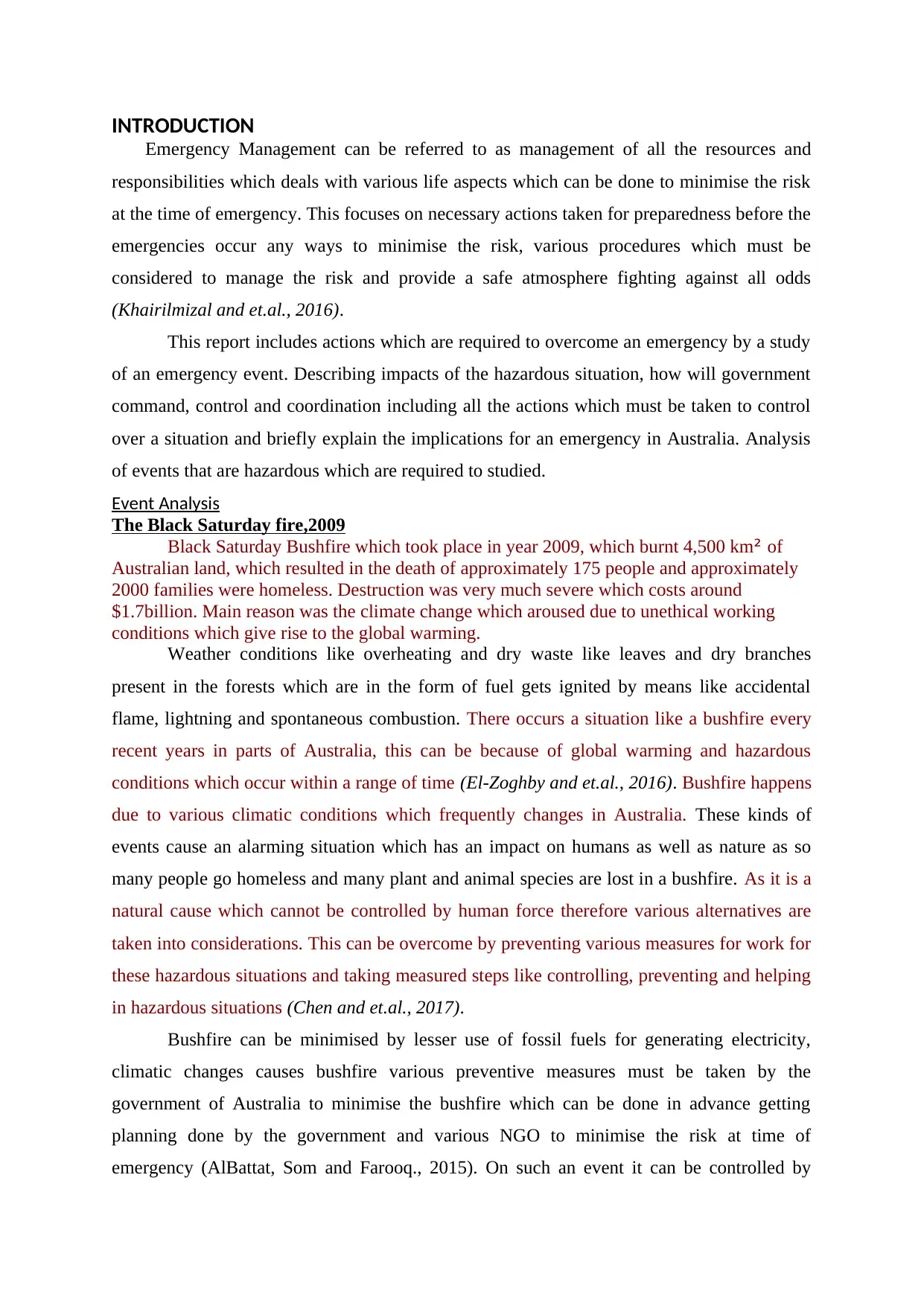
INTRODUCTION
Emergency Management can be referred to as management of all the resources and
responsibilities which deals with various life aspects which can be done to minimise the risk
at the time of emergency. This focuses on necessary actions taken for preparedness before the
emergencies occur any ways to minimise the risk, various procedures which must be
considered to manage the risk and provide a safe atmosphere fighting against all odds
(Khairilmizal and et.al., 2016).
This report includes actions which are required to overcome an emergency by a study
of an emergency event. Describing impacts of the hazardous situation, how will government
command, control and coordination including all the actions which must be taken to control
over a situation and briefly explain the implications for an emergency in Australia. Analysis
of events that are hazardous which are required to studied.
Event Analysis
The Black Saturday fire,2009
Black Saturday Bushfire which took place in year 2009, which burnt 4,500 km² of
Australian land, which resulted in the death of approximately 175 people and approximately
2000 families were homeless. Destruction was very much severe which costs around
$1.7billion. Main reason was the climate change which aroused due to unethical working
conditions which give rise to the global warming.
Weather conditions like overheating and dry waste like leaves and dry branches
present in the forests which are in the form of fuel gets ignited by means like accidental
flame, lightning and spontaneous combustion. There occurs a situation like a bushfire every
recent years in parts of Australia, this can be because of global warming and hazardous
conditions which occur within a range of time (El-Zoghby and et.al., 2016). Bushfire happens
due to various climatic conditions which frequently changes in Australia. These kinds of
events cause an alarming situation which has an impact on humans as well as nature as so
many people go homeless and many plant and animal species are lost in a bushfire. As it is a
natural cause which cannot be controlled by human force therefore various alternatives are
taken into considerations. This can be overcome by preventing various measures for work for
these hazardous situations and taking measured steps like controlling, preventing and helping
in hazardous situations (Chen and et.al., 2017).
Bushfire can be minimised by lesser use of fossil fuels for generating electricity,
climatic changes causes bushfire various preventive measures must be taken by the
government of Australia to minimise the bushfire which can be done in advance getting
planning done by the government and various NGO to minimise the risk at time of
emergency (AlBattat, Som and Farooq., 2015). On such an event it can be controlled by
Emergency Management can be referred to as management of all the resources and
responsibilities which deals with various life aspects which can be done to minimise the risk
at the time of emergency. This focuses on necessary actions taken for preparedness before the
emergencies occur any ways to minimise the risk, various procedures which must be
considered to manage the risk and provide a safe atmosphere fighting against all odds
(Khairilmizal and et.al., 2016).
This report includes actions which are required to overcome an emergency by a study
of an emergency event. Describing impacts of the hazardous situation, how will government
command, control and coordination including all the actions which must be taken to control
over a situation and briefly explain the implications for an emergency in Australia. Analysis
of events that are hazardous which are required to studied.
Event Analysis
The Black Saturday fire,2009
Black Saturday Bushfire which took place in year 2009, which burnt 4,500 km² of
Australian land, which resulted in the death of approximately 175 people and approximately
2000 families were homeless. Destruction was very much severe which costs around
$1.7billion. Main reason was the climate change which aroused due to unethical working
conditions which give rise to the global warming.
Weather conditions like overheating and dry waste like leaves and dry branches
present in the forests which are in the form of fuel gets ignited by means like accidental
flame, lightning and spontaneous combustion. There occurs a situation like a bushfire every
recent years in parts of Australia, this can be because of global warming and hazardous
conditions which occur within a range of time (El-Zoghby and et.al., 2016). Bushfire happens
due to various climatic conditions which frequently changes in Australia. These kinds of
events cause an alarming situation which has an impact on humans as well as nature as so
many people go homeless and many plant and animal species are lost in a bushfire. As it is a
natural cause which cannot be controlled by human force therefore various alternatives are
taken into considerations. This can be overcome by preventing various measures for work for
these hazardous situations and taking measured steps like controlling, preventing and helping
in hazardous situations (Chen and et.al., 2017).
Bushfire can be minimised by lesser use of fossil fuels for generating electricity,
climatic changes causes bushfire various preventive measures must be taken by the
government of Australia to minimise the bushfire which can be done in advance getting
planning done by the government and various NGO to minimise the risk at time of
emergency (AlBattat, Som and Farooq., 2015). On such an event it can be controlled by
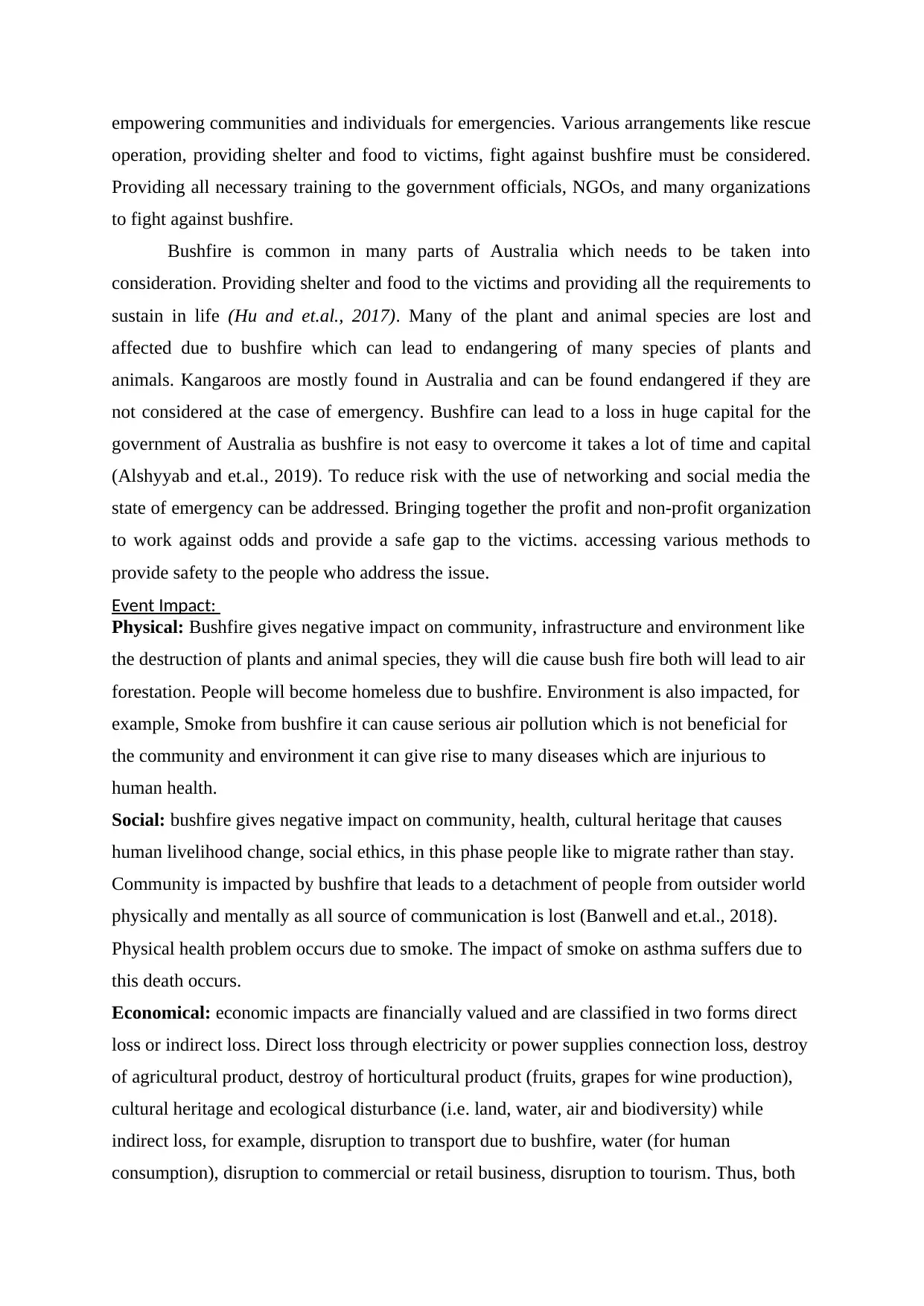
empowering communities and individuals for emergencies. Various arrangements like rescue
operation, providing shelter and food to victims, fight against bushfire must be considered.
Providing all necessary training to the government officials, NGOs, and many organizations
to fight against bushfire.
Bushfire is common in many parts of Australia which needs to be taken into
consideration. Providing shelter and food to the victims and providing all the requirements to
sustain in life (Hu and et.al., 2017). Many of the plant and animal species are lost and
affected due to bushfire which can lead to endangering of many species of plants and
animals. Kangaroos are mostly found in Australia and can be found endangered if they are
not considered at the case of emergency. Bushfire can lead to a loss in huge capital for the
government of Australia as bushfire is not easy to overcome it takes a lot of time and capital
(Alshyyab and et.al., 2019). To reduce risk with the use of networking and social media the
state of emergency can be addressed. Bringing together the profit and non-profit organization
to work against odds and provide a safe gap to the victims. accessing various methods to
provide safety to the people who address the issue.
Event Impact:
Physical: Bushfire gives negative impact on community, infrastructure and environment like
the destruction of plants and animal species, they will die cause bush fire both will lead to air
forestation. People will become homeless due to bushfire. Environment is also impacted, for
example, Smoke from bushfire it can cause serious air pollution which is not beneficial for
the community and environment it can give rise to many diseases which are injurious to
human health.
Social: bushfire gives negative impact on community, health, cultural heritage that causes
human livelihood change, social ethics, in this phase people like to migrate rather than stay.
Community is impacted by bushfire that leads to a detachment of people from outsider world
physically and mentally as all source of communication is lost (Banwell and et.al., 2018).
Physical health problem occurs due to smoke. The impact of smoke on asthma suffers due to
this death occurs.
Economical: economic impacts are financially valued and are classified in two forms direct
loss or indirect loss. Direct loss through electricity or power supplies connection loss, destroy
of agricultural product, destroy of horticultural product (fruits, grapes for wine production),
cultural heritage and ecological disturbance (i.e. land, water, air and biodiversity) while
indirect loss, for example, disruption to transport due to bushfire, water (for human
consumption), disruption to commercial or retail business, disruption to tourism. Thus, both
operation, providing shelter and food to victims, fight against bushfire must be considered.
Providing all necessary training to the government officials, NGOs, and many organizations
to fight against bushfire.
Bushfire is common in many parts of Australia which needs to be taken into
consideration. Providing shelter and food to the victims and providing all the requirements to
sustain in life (Hu and et.al., 2017). Many of the plant and animal species are lost and
affected due to bushfire which can lead to endangering of many species of plants and
animals. Kangaroos are mostly found in Australia and can be found endangered if they are
not considered at the case of emergency. Bushfire can lead to a loss in huge capital for the
government of Australia as bushfire is not easy to overcome it takes a lot of time and capital
(Alshyyab and et.al., 2019). To reduce risk with the use of networking and social media the
state of emergency can be addressed. Bringing together the profit and non-profit organization
to work against odds and provide a safe gap to the victims. accessing various methods to
provide safety to the people who address the issue.
Event Impact:
Physical: Bushfire gives negative impact on community, infrastructure and environment like
the destruction of plants and animal species, they will die cause bush fire both will lead to air
forestation. People will become homeless due to bushfire. Environment is also impacted, for
example, Smoke from bushfire it can cause serious air pollution which is not beneficial for
the community and environment it can give rise to many diseases which are injurious to
human health.
Social: bushfire gives negative impact on community, health, cultural heritage that causes
human livelihood change, social ethics, in this phase people like to migrate rather than stay.
Community is impacted by bushfire that leads to a detachment of people from outsider world
physically and mentally as all source of communication is lost (Banwell and et.al., 2018).
Physical health problem occurs due to smoke. The impact of smoke on asthma suffers due to
this death occurs.
Economical: economic impacts are financially valued and are classified in two forms direct
loss or indirect loss. Direct loss through electricity or power supplies connection loss, destroy
of agricultural product, destroy of horticultural product (fruits, grapes for wine production),
cultural heritage and ecological disturbance (i.e. land, water, air and biodiversity) while
indirect loss, for example, disruption to transport due to bushfire, water (for human
consumption), disruption to commercial or retail business, disruption to tourism. Thus, both
Secure Best Marks with AI Grader
Need help grading? Try our AI Grader for instant feedback on your assignments.

losses directly impact on Australian’s economy.
Political: it gives an impact on government policies. Bushfire causes government will be
unable to give policy services to people. It will disturb the relation of peoples and will create
a crisis because of a change in policy. People will revolt of government which will give
negative impact on the Australian government.
Environmental: weather condition leads to bushfire that causes climate change. Bushfire
gives negative impact on ecosystem physically, chemically, biologically. Environment is
polluted due to smoke of bushfire. It causes climate change so that increasing number of hot
days and heatwaves. In this state possibilities high fire danger weather (Jebens and Sorensen.,
2018). Climate change causes drought condition can occur and deficiency of oxygen in the
environment leads danger zone for the community.
Command, control & coordination:
Command: Government takes an impressive step to prevent bushfire. It works on such kind
operations by command. Government first organize a meeting where gives command
emergency coordination centre to overcome from bushfire incident. It in-trusts professional
firefighters for controlling fire. 14000 professional firefighters are required by a team which
is arranged by the government. Immediate emergency during bushfire is controlled by the
government which takes help of various NGO's to overcome the situation of bushfire. , it
joins with the rescue team and sometimes takes help of aircraft which is commanded by the
government (Curnin and et.al., 2015). It also organizes some bushfire management where it
separated into two categories firefighting emergency, fire prevention. It also commands
NGO'S for helping the suffering people from disease. It also gives another services like
financial support to suffered people by the rebuilding, of infrastructure and the recovery of
state or national park. Thus, type of government command all staff and allocate
responsibilities.
Control: Australian government controls on bushfire by team generation of various sectors
which work for the safety at natural calamity. (Goldschmidt and Kumar., 2016). Firstly,
vacant that spotted place by the help of the police team then firefighters team takes position
on that spot or covered area and try to control on fire. In an emergency a firefighter team
requires a rescue team when many suffered people are stuck in the fire then government
allocate rescue team. Sometimes a firefighter team require aircraft help for controlling fire
through water. Then the government send aircraft for assist team by dumping water. It
organizes some campaign for helping suffered people through water, cloth, foods and home.
This type of government control bushfire operation.
Political: it gives an impact on government policies. Bushfire causes government will be
unable to give policy services to people. It will disturb the relation of peoples and will create
a crisis because of a change in policy. People will revolt of government which will give
negative impact on the Australian government.
Environmental: weather condition leads to bushfire that causes climate change. Bushfire
gives negative impact on ecosystem physically, chemically, biologically. Environment is
polluted due to smoke of bushfire. It causes climate change so that increasing number of hot
days and heatwaves. In this state possibilities high fire danger weather (Jebens and Sorensen.,
2018). Climate change causes drought condition can occur and deficiency of oxygen in the
environment leads danger zone for the community.
Command, control & coordination:
Command: Government takes an impressive step to prevent bushfire. It works on such kind
operations by command. Government first organize a meeting where gives command
emergency coordination centre to overcome from bushfire incident. It in-trusts professional
firefighters for controlling fire. 14000 professional firefighters are required by a team which
is arranged by the government. Immediate emergency during bushfire is controlled by the
government which takes help of various NGO's to overcome the situation of bushfire. , it
joins with the rescue team and sometimes takes help of aircraft which is commanded by the
government (Curnin and et.al., 2015). It also organizes some bushfire management where it
separated into two categories firefighting emergency, fire prevention. It also commands
NGO'S for helping the suffering people from disease. It also gives another services like
financial support to suffered people by the rebuilding, of infrastructure and the recovery of
state or national park. Thus, type of government command all staff and allocate
responsibilities.
Control: Australian government controls on bushfire by team generation of various sectors
which work for the safety at natural calamity. (Goldschmidt and Kumar., 2016). Firstly,
vacant that spotted place by the help of the police team then firefighters team takes position
on that spot or covered area and try to control on fire. In an emergency a firefighter team
requires a rescue team when many suffered people are stuck in the fire then government
allocate rescue team. Sometimes a firefighter team require aircraft help for controlling fire
through water. Then the government send aircraft for assist team by dumping water. It
organizes some campaign for helping suffered people through water, cloth, foods and home.
This type of government control bushfire operation.
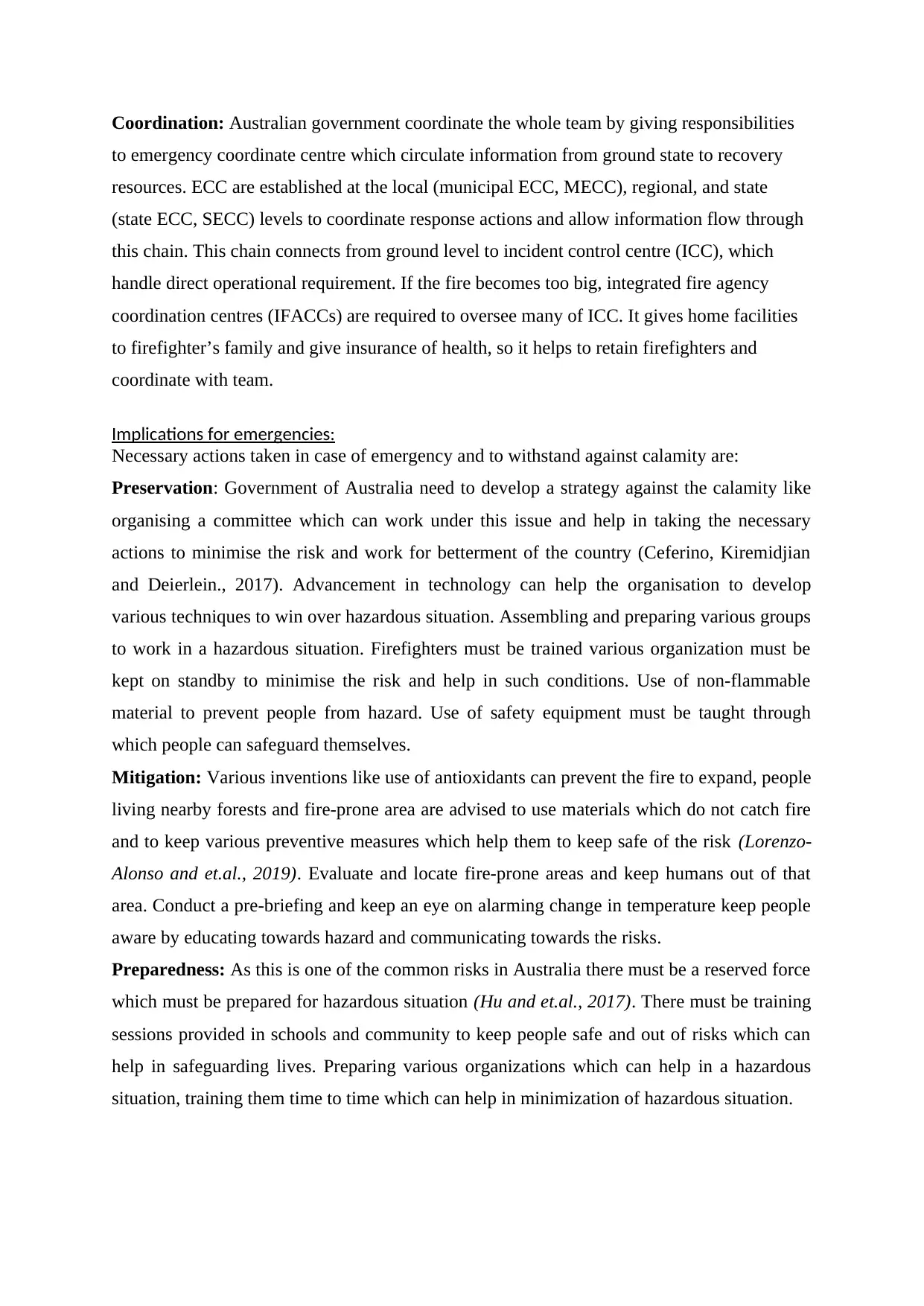
Coordination: Australian government coordinate the whole team by giving responsibilities
to emergency coordinate centre which circulate information from ground state to recovery
resources. ECC are established at the local (municipal ECC, MECC), regional, and state
(state ECC, SECC) levels to coordinate response actions and allow information flow through
this chain. This chain connects from ground level to incident control centre (ICC), which
handle direct operational requirement. If the fire becomes too big, integrated fire agency
coordination centres (IFACCs) are required to oversee many of ICC. It gives home facilities
to firefighter’s family and give insurance of health, so it helps to retain firefighters and
coordinate with team.
Implications for emergencies:
Necessary actions taken in case of emergency and to withstand against calamity are:
Preservation: Government of Australia need to develop a strategy against the calamity like
organising a committee which can work under this issue and help in taking the necessary
actions to minimise the risk and work for betterment of the country (Ceferino, Kiremidjian
and Deierlein., 2017). Advancement in technology can help the organisation to develop
various techniques to win over hazardous situation. Assembling and preparing various groups
to work in a hazardous situation. Firefighters must be trained various organization must be
kept on standby to minimise the risk and help in such conditions. Use of non-flammable
material to prevent people from hazard. Use of safety equipment must be taught through
which people can safeguard themselves.
Mitigation: Various inventions like use of antioxidants can prevent the fire to expand, people
living nearby forests and fire-prone area are advised to use materials which do not catch fire
and to keep various preventive measures which help them to keep safe of the risk (Lorenzo-
Alonso and et.al., 2019). Evaluate and locate fire-prone areas and keep humans out of that
area. Conduct a pre-briefing and keep an eye on alarming change in temperature keep people
aware by educating towards hazard and communicating towards the risks.
Preparedness: As this is one of the common risks in Australia there must be a reserved force
which must be prepared for hazardous situation (Hu and et.al., 2017). There must be training
sessions provided in schools and community to keep people safe and out of risks which can
help in safeguarding lives. Preparing various organizations which can help in a hazardous
situation, training them time to time which can help in minimization of hazardous situation.
to emergency coordinate centre which circulate information from ground state to recovery
resources. ECC are established at the local (municipal ECC, MECC), regional, and state
(state ECC, SECC) levels to coordinate response actions and allow information flow through
this chain. This chain connects from ground level to incident control centre (ICC), which
handle direct operational requirement. If the fire becomes too big, integrated fire agency
coordination centres (IFACCs) are required to oversee many of ICC. It gives home facilities
to firefighter’s family and give insurance of health, so it helps to retain firefighters and
coordinate with team.
Implications for emergencies:
Necessary actions taken in case of emergency and to withstand against calamity are:
Preservation: Government of Australia need to develop a strategy against the calamity like
organising a committee which can work under this issue and help in taking the necessary
actions to minimise the risk and work for betterment of the country (Ceferino, Kiremidjian
and Deierlein., 2017). Advancement in technology can help the organisation to develop
various techniques to win over hazardous situation. Assembling and preparing various groups
to work in a hazardous situation. Firefighters must be trained various organization must be
kept on standby to minimise the risk and help in such conditions. Use of non-flammable
material to prevent people from hazard. Use of safety equipment must be taught through
which people can safeguard themselves.
Mitigation: Various inventions like use of antioxidants can prevent the fire to expand, people
living nearby forests and fire-prone area are advised to use materials which do not catch fire
and to keep various preventive measures which help them to keep safe of the risk (Lorenzo-
Alonso and et.al., 2019). Evaluate and locate fire-prone areas and keep humans out of that
area. Conduct a pre-briefing and keep an eye on alarming change in temperature keep people
aware by educating towards hazard and communicating towards the risks.
Preparedness: As this is one of the common risks in Australia there must be a reserved force
which must be prepared for hazardous situation (Hu and et.al., 2017). There must be training
sessions provided in schools and community to keep people safe and out of risks which can
help in safeguarding lives. Preparing various organizations which can help in a hazardous
situation, training them time to time which can help in minimization of hazardous situation.
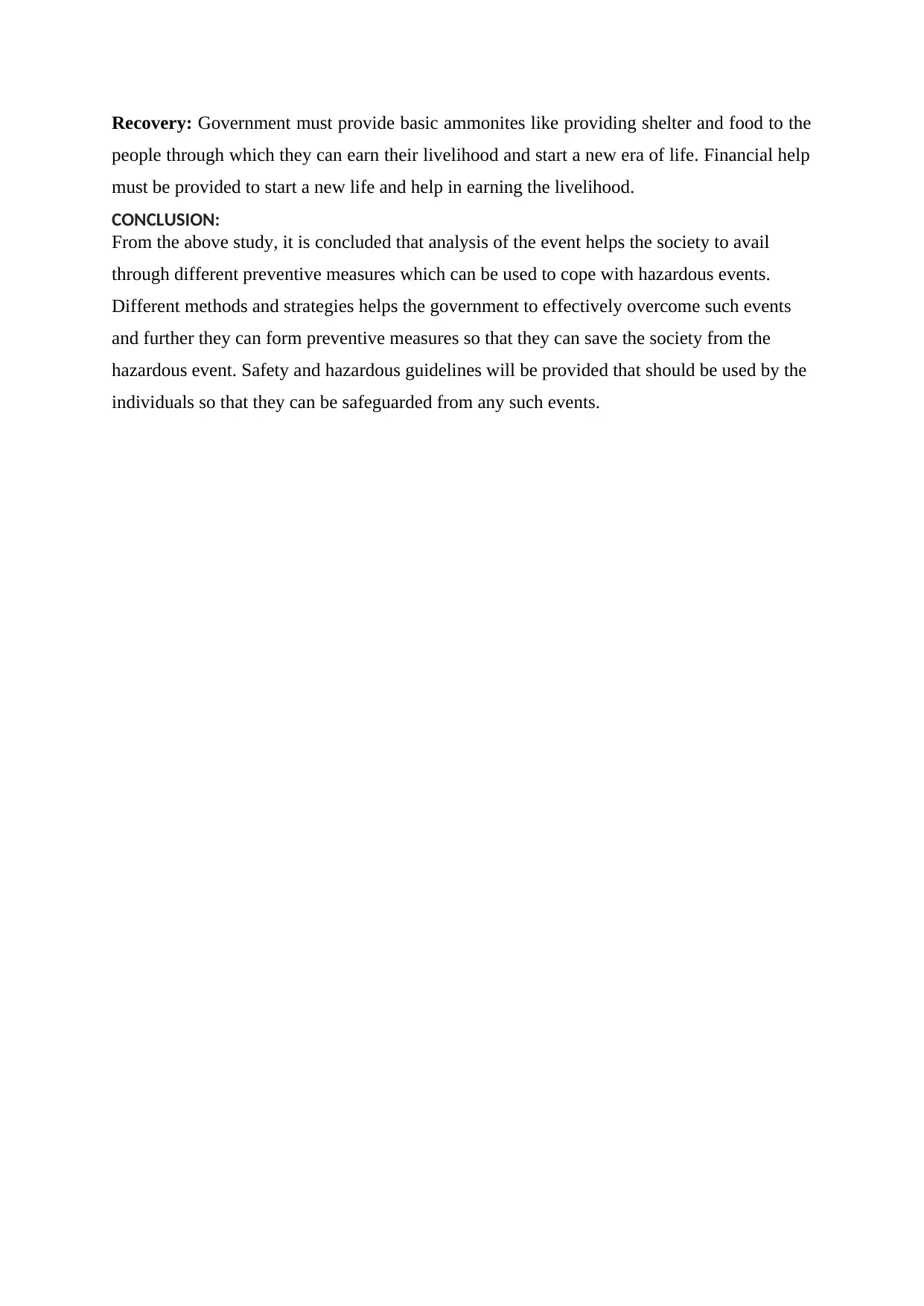
Recovery: Government must provide basic ammonites like providing shelter and food to the
people through which they can earn their livelihood and start a new era of life. Financial help
must be provided to start a new life and help in earning the livelihood.
CONCLUSION:
From the above study, it is concluded that analysis of the event helps the society to avail
through different preventive measures which can be used to cope with hazardous events.
Different methods and strategies helps the government to effectively overcome such events
and further they can form preventive measures so that they can save the society from the
hazardous event. Safety and hazardous guidelines will be provided that should be used by the
individuals so that they can be safeguarded from any such events.
people through which they can earn their livelihood and start a new era of life. Financial help
must be provided to start a new life and help in earning the livelihood.
CONCLUSION:
From the above study, it is concluded that analysis of the event helps the society to avail
through different preventive measures which can be used to cope with hazardous events.
Different methods and strategies helps the government to effectively overcome such events
and further they can form preventive measures so that they can save the society from the
hazardous event. Safety and hazardous guidelines will be provided that should be used by the
individuals so that they can be safeguarded from any such events.
Paraphrase This Document
Need a fresh take? Get an instant paraphrase of this document with our AI Paraphraser
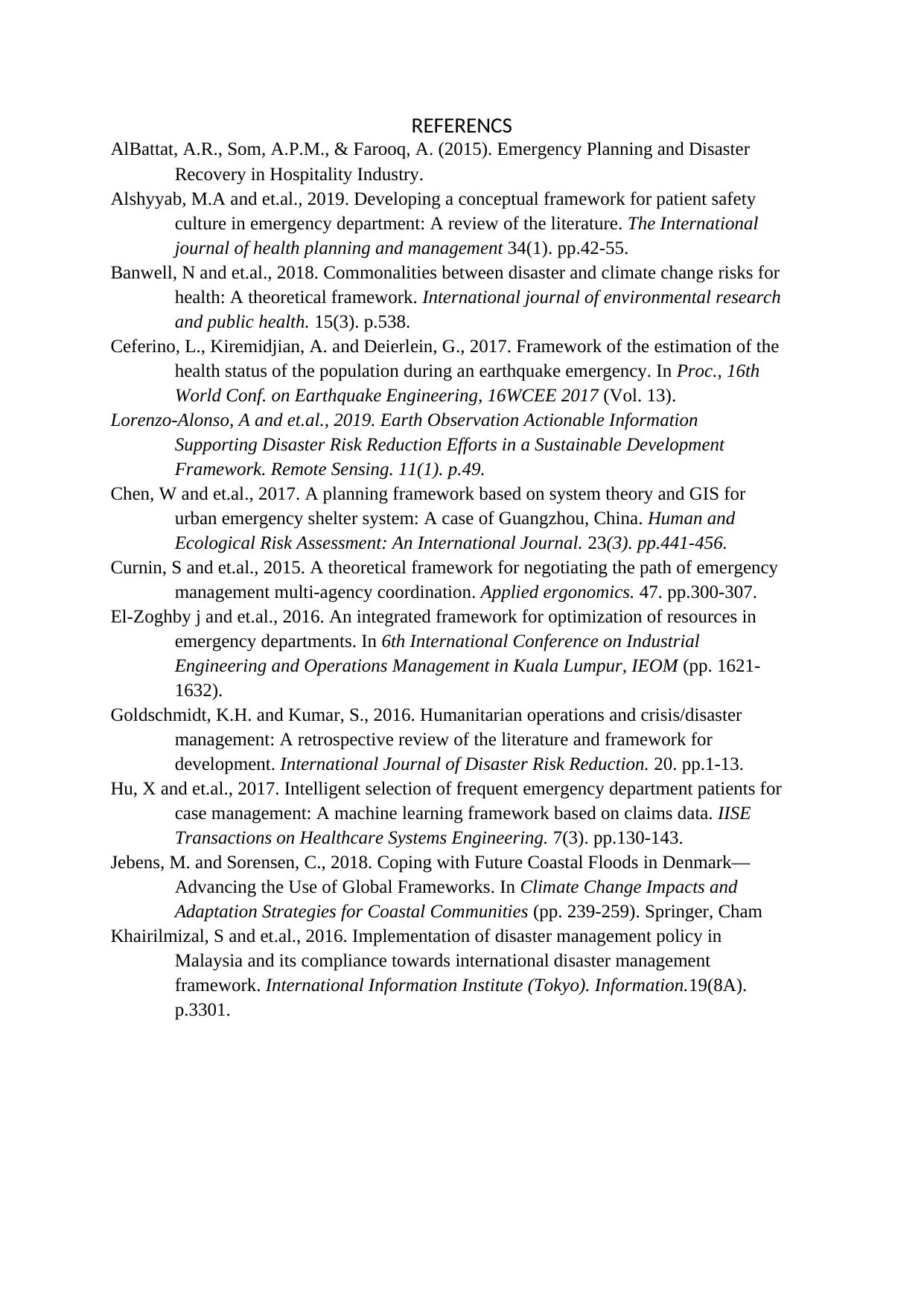
REFERENCS
AlBattat, A.R., Som, A.P.M., & Farooq, A. (2015). Emergency Planning and Disaster
Recovery in Hospitality Industry.
Alshyyab, M.A and et.al., 2019. Developing a conceptual framework for patient safety
culture in emergency department: A review of the literature. The International
journal of health planning and management 34(1). pp.42-55.
Banwell, N and et.al., 2018. Commonalities between disaster and climate change risks for
health: A theoretical framework. International journal of environmental research
and public health. 15(3). p.538.
Ceferino, L., Kiremidjian, A. and Deierlein, G., 2017. Framework of the estimation of the
health status of the population during an earthquake emergency. In Proc., 16th
World Conf. on Earthquake Engineering, 16WCEE 2017 (Vol. 13).
Lorenzo-Alonso, A and et.al., 2019. Earth Observation Actionable Information
Supporting Disaster Risk Reduction Efforts in a Sustainable Development
Framework. Remote Sensing. 11(1). p.49.
Chen, W and et.al., 2017. A planning framework based on system theory and GIS for
urban emergency shelter system: A case of Guangzhou, China. Human and
Ecological Risk Assessment: An International Journal. 23(3). pp.441-456.
Curnin, S and et.al., 2015. A theoretical framework for negotiating the path of emergency
management multi-agency coordination. Applied ergonomics. 47. pp.300-307.
El-Zoghby j and et.al., 2016. An integrated framework for optimization of resources in
emergency departments. In 6th International Conference on Industrial
Engineering and Operations Management in Kuala Lumpur, IEOM (pp. 1621-
1632).
Goldschmidt, K.H. and Kumar, S., 2016. Humanitarian operations and crisis/disaster
management: A retrospective review of the literature and framework for
development. International Journal of Disaster Risk Reduction. 20. pp.1-13.
Hu, X and et.al., 2017. Intelligent selection of frequent emergency department patients for
case management: A machine learning framework based on claims data. IISE
Transactions on Healthcare Systems Engineering. 7(3). pp.130-143.
Jebens, M. and Sorensen, C., 2018. Coping with Future Coastal Floods in Denmark—
Advancing the Use of Global Frameworks. In Climate Change Impacts and
Adaptation Strategies for Coastal Communities (pp. 239-259). Springer, Cham
Khairilmizal, S and et.al., 2016. Implementation of disaster management policy in
Malaysia and its compliance towards international disaster management
framework. International Information Institute (Tokyo). Information.19(8A).
p.3301.
AlBattat, A.R., Som, A.P.M., & Farooq, A. (2015). Emergency Planning and Disaster
Recovery in Hospitality Industry.
Alshyyab, M.A and et.al., 2019. Developing a conceptual framework for patient safety
culture in emergency department: A review of the literature. The International
journal of health planning and management 34(1). pp.42-55.
Banwell, N and et.al., 2018. Commonalities between disaster and climate change risks for
health: A theoretical framework. International journal of environmental research
and public health. 15(3). p.538.
Ceferino, L., Kiremidjian, A. and Deierlein, G., 2017. Framework of the estimation of the
health status of the population during an earthquake emergency. In Proc., 16th
World Conf. on Earthquake Engineering, 16WCEE 2017 (Vol. 13).
Lorenzo-Alonso, A and et.al., 2019. Earth Observation Actionable Information
Supporting Disaster Risk Reduction Efforts in a Sustainable Development
Framework. Remote Sensing. 11(1). p.49.
Chen, W and et.al., 2017. A planning framework based on system theory and GIS for
urban emergency shelter system: A case of Guangzhou, China. Human and
Ecological Risk Assessment: An International Journal. 23(3). pp.441-456.
Curnin, S and et.al., 2015. A theoretical framework for negotiating the path of emergency
management multi-agency coordination. Applied ergonomics. 47. pp.300-307.
El-Zoghby j and et.al., 2016. An integrated framework for optimization of resources in
emergency departments. In 6th International Conference on Industrial
Engineering and Operations Management in Kuala Lumpur, IEOM (pp. 1621-
1632).
Goldschmidt, K.H. and Kumar, S., 2016. Humanitarian operations and crisis/disaster
management: A retrospective review of the literature and framework for
development. International Journal of Disaster Risk Reduction. 20. pp.1-13.
Hu, X and et.al., 2017. Intelligent selection of frequent emergency department patients for
case management: A machine learning framework based on claims data. IISE
Transactions on Healthcare Systems Engineering. 7(3). pp.130-143.
Jebens, M. and Sorensen, C., 2018. Coping with Future Coastal Floods in Denmark—
Advancing the Use of Global Frameworks. In Climate Change Impacts and
Adaptation Strategies for Coastal Communities (pp. 239-259). Springer, Cham
Khairilmizal, S and et.al., 2016. Implementation of disaster management policy in
Malaysia and its compliance towards international disaster management
framework. International Information Institute (Tokyo). Information.19(8A).
p.3301.
1 out of 8
Related Documents
Your All-in-One AI-Powered Toolkit for Academic Success.
+13062052269
info@desklib.com
Available 24*7 on WhatsApp / Email
![[object Object]](/_next/static/media/star-bottom.7253800d.svg)
Unlock your academic potential
© 2024 | Zucol Services PVT LTD | All rights reserved.




